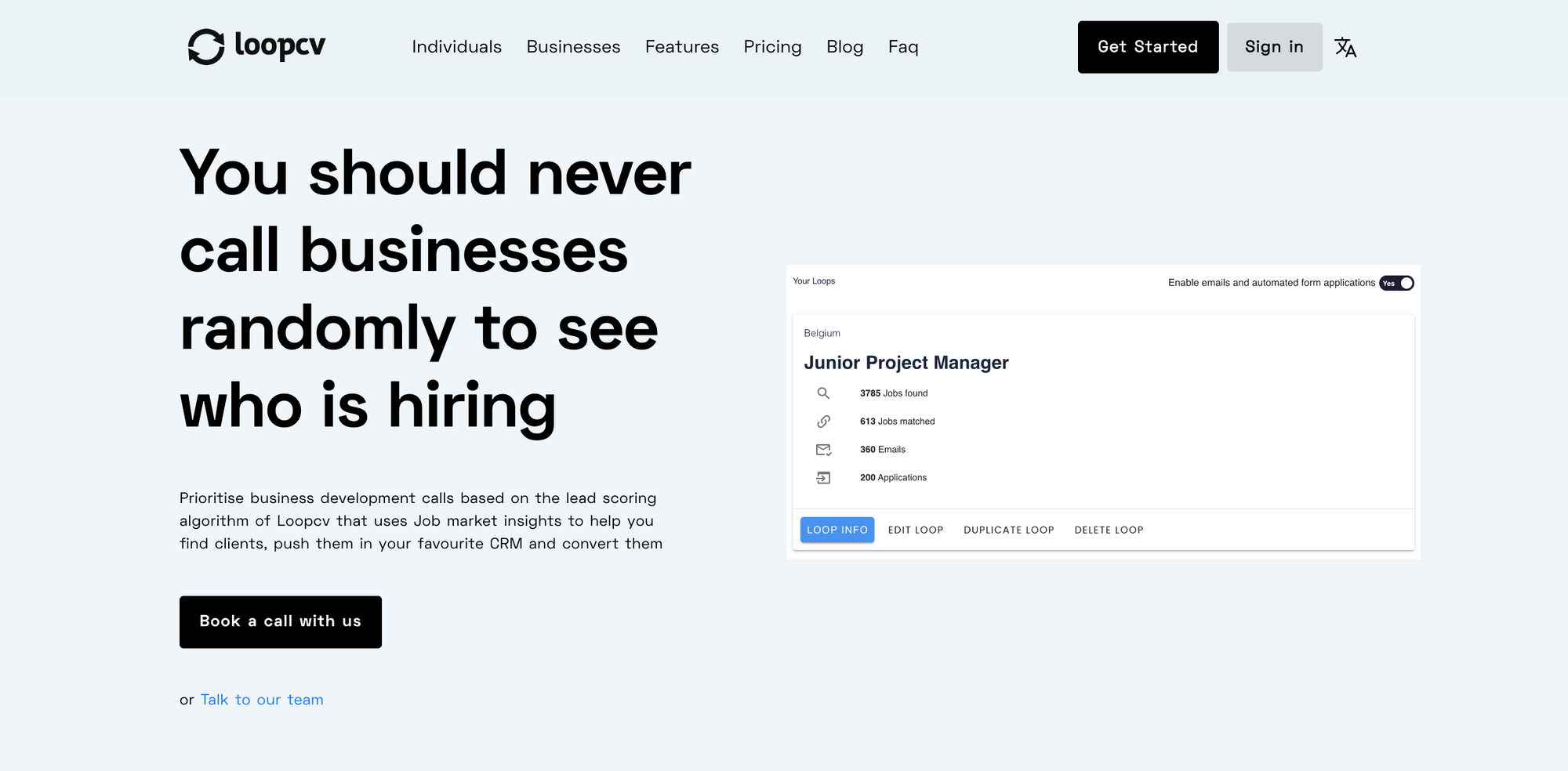How to get leads as a recruiter? A Complete Guide for Recruitment Agencies
Are you a recruiter or recruitment agency struggling to generate leads and secure contracts?
Finding the right candidates and clients can be a daunting task in the competitive job market.
So, let's see what you can do in order to achieve your goals on that matter!
We'll cover the following topics:
- What is a lead in recruitment
- How To Generate Leads In Recruitment
- How to get recruiting contracts
- Lead generation for recruitment agencies
- How to generate new business in recruitment.
What is a lead in recruitment
In the recruitment industry, a lead refers to a potential candidate or client that has been identified as a potential fit for an open position or a company in need of recruiting services.
These leads can come in many forms, such as job seekers who have recently applied for a position, companies that have recently posted job openings, or industry professionals who may know of potential candidates or clients.
Identifying and pursuing leads is crucial in the recruitment process as it allows recruiters to target their efforts and increase the chances of making successful placements.
For example, a lead can be a job seeker who has recently graduated from college with a degree in engineering and is actively searching for a job in the field. By targeting this lead, a recruiter can increase the chances of making a successful placement for an engineering position.
Similarly, a lead can be a company that is expanding its operations and is in need of recruiting a large number of employees. By identifying this lead, a recruitment agency can offer its services and help the company find the right candidates for the open positions.
But, there is something you need to be aware of:
It's important to note that not all leads are equal, some may be more qualified or more likely to convert into successful placements. Therefore, it's crucial to prioritize leads based on their qualifications and potential fit for the open position or the company's recruiting needs.
In addition to job seekers and companies, leads can also come from industry professionals such as headhunters, hiring managers and other recruiters. These individuals can provide valuable insights and connections that can help recruiters identify potential candidates and clients.
How To Generate Leads In Recruitment
Generating leads in recruitment requires a proactive approach and a variety of strategies.
One effective method for generating leads is networking and building relationships with industry professionals.
This can include attending networking events, joining industry associations, and building connections on LinkedIn. Additionally, attending job fairs and recruiting events can provide recruiters with access to potential candidates and clients.
Another effective strategy for generating leads is utilizing social media and online job boards.
Platforms such as LinkedIn and Indeed can be used to target potential candidates and clients, and social media can be used to showcase a company's brand and attract potential candidates.
Recruiters can also leverage data and analytics to identify potential candidates and clients.
By analyzing job postings, salary data, and other relevant information, recruiters can identify in-demand job positions and target potential candidates and clients in those areas.
Once leads have been generated, it is crucial to follow up with them in a timely manner. This can include sending bulk personalized SMS messages or emails, scheduling phone or in-person meetings, or providing additional information about the company or open position.
Another tip for lead generation is to use long-tail keywords to optimize your online presence. Long-tail keywords are more specific, longer phrases that target a more specific audience.
For example, instead of using "recruitment agency" as a keyword, you could use "best recruitment agency for IT jobs in New York City". By using long-tail keywords, you can increase the chances of your website or job postings appearing in search results for specific searches.
Obtaining leads in recruitment is a proactive pursuit that requires a multifaceted approach. It's not just about sitting back and waiting for them to come to you, it's about actively seeking out potential candidates and clients through a diverse range of strategies.
Networking and building relationships with industry professionals, attending job fairs and recruiting events, utilizing social media and online job boards, and leveraging data and analytics to identify potential candidates and clients are effective methods for generating leads.
Following up with leads in a timely manner and using long-tail keywords to optimize your online presence can also help increase the chances of generating leads.
How to get recruiting contracts
Securing contracts as a recruiter, whether you work independently or as part of an agency, is crucial for the success of your business.
Building strong relationships with clients is essential as it helps to establish trust and demonstrate your capabilities as a recruiter.
This can be done by attending networking events, joining industry associations, and building connections on LinkedIn.
Demonstrating your expertise and experience in the industry is also important for securing contracts. This can be done by showcasing a track record of successful placements, highlighting your specialties, and providing testimonials from satisfied clients.
When pitching your services to potential clients, it is important to clearly outline the terms of the contract and negotiate the terms that work best for both parties. This may include discussing fees, the recruitment process, and the length of the contract.
Acquiring contracts is a vital step in the journey of any freelance recruiter or recruitment agency. Without them, the business will be like a ship without a rudder, drifting aimlessly in the sea of competition.
Building strong relationships, demonstrating expertise and experience, and having a track record of successful placements are important steps in the process. Additionally, using long-
Lead generation for recruitment agencies
Lead generation for recruitment agencies can be a complex and challenging task. However, by breaking it down into a simple framework and providing actionable and practical takeaways, the process can become much more manageable.
The first step in generating leads for recruitment agencies is to identify your target audience. This includes understanding the types of companies and industries that are in need of recruitment services, as well as the specific roles and positions that they are looking to fill.
Once you have identified your target audience, it's important to create a clear and compelling value proposition. This should highlight the unique benefits and advantages of your recruitment services, and clearly communicate how you can help companies to solve their recruitment challenges.
Next, it's important to create a solid lead generation plan. This can include using lead generation forms, networking, social media marketing, content marketing, and email marketing. Recruitment agencies can also consider outsourcing to specialized B2B lead generation services like CallingAgency to streamline their client acquisition process and focus more on placements. It's important to test and measure the effectiveness of each tactic, and continuously optimize and improve your lead generation efforts.
Finally, it's crucial to have a robust follow-up and nurturing process in place. This includes staying in touch with leads, building relationships and staying top of mind.
It is also important to track leads and conversions, this way you can better understand which leads are most likely to convert into clients. It’ll also help you boost conversion rates in a data-driven manner.
Lead generation for recruitment agencies is like navigating a labyrinth - it can be challenging, but with the right tools, you can reach the treasure. By zeroing in on your ideal clients, crafting a unique selling point, mapping out a strategic plan and being consistent with your follow-up, you can increase your chances of success in the highly competitive recruitment industry
How to generate new business in recruitment
Generating new business in recruitment is essential to the success of any freelance recruiter or agency, but it's not always easy.
However, by taking a strategic and creative approach, you can increase your chances of success.
Here are 10+1 tactics we believe will be more than worth your while, along with actionable advice on how best to implement each of them!
Bonus: How a recruitment agency is finding clients by using Loopcv
Check out this case study:
A global tech recruitment agency with presence in Athens, Lisbon, London & New York, specializing in IT, Digital Marketing & Engineering trusted our platform to find the right applicants for their company!
How do they use our tool?
1. The first one is the Job Seeker Dashboard.
This dashboard is used by your clients (job seekers) to define their job search criteria and work daily on the results and applying for new jobs.
2. The second environment is the Admin’s Dashboard.
An environment where the account managers of the organizations can manage the users, check their progress and have a high level overview of how their customers use the platform.
There are 2 main emailing flows that Loopcv provides:
a. Automated email submissions sent by company's
subdomain white labeled email (e.g., careers@jobs.company.com)
b. Automated email submissions received by companies’ HR Departments and/or decision makers in order to be reviewed.
c. Responsive emails (positive/negative ones) to be sent back to company's subdomain email (e.g., careers@jobs.company.com)
a. Automated email submissions sent by user's subdomain white labeled email (e.g., firstname.lastname@jobs.company.com)
b. Automated email submissions received by companies’ HR Departments or decision makers in order to be reviewed.
c. Responsive emails (positive/negative ones) to be sent back to company's subdomain email (e.g., careers@jobs.company.com)
c. Responsive emails (positive/negative ones) to be sent to user's subdomain email (e.g., firstname.lastname@jobs.company.com). Emails could be also sent to their personal email addresses.
How is the Setup and Onboarding Happening?
The set up and onboarding process typically takes 1 business day to ensure that Loopcv can prepare all the invites to the admin/manager accounts and set up the user accounts with all the required details.
The steps are described below:
➔ Creation of the team member accounts
➔ Configuration of the job search roles and the locations per user
➔ Integration of your business domain
➔ Connection with custom domain for white-labeled notifications to candidates
➔ Setup of your logo and branding look and feel
➔ Technical configuration based on your needs
➔ Email invitation system enablement
➔ Alias email configuration
The Training and Activation Process
The training and activation process contains the following actions:
➔ 2 training sessions (1 hour) showcasing how the platform works
➔ Customer success session to ensure that all the processes are clear and all questions have been answered (1 hour)
➔ Additional sessions per request to ensure that both administrators/managers but also other team members involved in the process have a clear picture of how the platform works.
How much time have they saved?
Loopcv's standout feature is its ability to automatically generate leads in real-time.
This eliminates the need for users to individually send emails once they have collected necessary data for doing so, streamlining the application process and increasing the chances of timely submissions.
1. Make your business much easier, extremely much easier by using our service Loopcv!

You should never call businesses randomly to see who is hiring! That sounds awesome, isn't it?
You can use our platform to find companies who are looking for positions and send automated emails!
2. Networking:
Attend industry events and conferences, join relevant professional organizations, and connect with other recruiters and hiring managers to build relationships and generate leads. Be sure to follow up with new connections to keep the conversation going.
3.Social media marketing:
Use social media platforms like LinkedIn, Twitter, and Facebook to promote your services, share relevant content, and engage with potential clients.
Remember to be consistent and engaging in your posts, and to use relevant hashtags to reach a wider audience.
4. Content marketing:
Create valuable and informative content such as blog posts, e-books, and webinars to attract potential clients and establish your agency as a thought leader in the industry.
You can also create engaging podcasts, as they are quite popular and easy to create, even with little experience.
Use analytics to measure the effectiveness of your content and adjust your strategy accordingly.
5. Email marketing:
Use targeted email marketing to boost conversion rates and stay in touch with leads. Personalize your messages and make them relevant to the recipient, include calls to action and track the open rates, click-through rates and conversion rates.
6. Referral marketing:
Encourage current clients and industry contacts to refer new business to your agency. Offer incentives and bonuses to clients who refer new business to you.
7. Pay-per-click advertising:
Use platforms like Google AdWords and LinkedIn Ads to target potential clients with specific job titles or industries. Keep track of the campaign's performance, and adjust your targeting and budget accordingly.
8. Influencer marketing:
Partner with industry influencers and thought leaders to reach new audiences and generate leads.
Identify influencers in your industry who have an engaged following and approach them with a clear strategy on how you can help them, and how it will benefit both of you.
9. Trade shows and events:
Attend trade shows and events that are specific to your target market to connect with potential clients and generate leads. Prepare business cards and brochures and have a clear message or a unique proposition that sets you apart from the competition. Follow up with leads after the event to keep the conversation going.
10. Public Relations:
Use PR to establish your agency as an authority in the industry, and to reach new audiences through media coverage and interviews. Create a press release, a media kit, and prepare for interviews.
10+1 Cold calling:
Reach out to potential clients directly through phone or email and introduce your agency and services. Prepare a script and be ready for objections, have a clear call-to-action and follow up with leads after the call.
Through a combination of these tactics, you will increase your chances of success and grow your client base.
It's important to remember that lead generation is not a one-time event, it's a continuous process. To get the best results, it's essential to track your progress, measure your success, and continually adjust your strategy.
Once you have a good lead generation process in place, you can focus on building relationships with your clients and providing exceptional service to ensure long-term success.
Now, take action, choose your favorite tactics and start implementing them today! Remember, the best way to predict the future is to create it.



